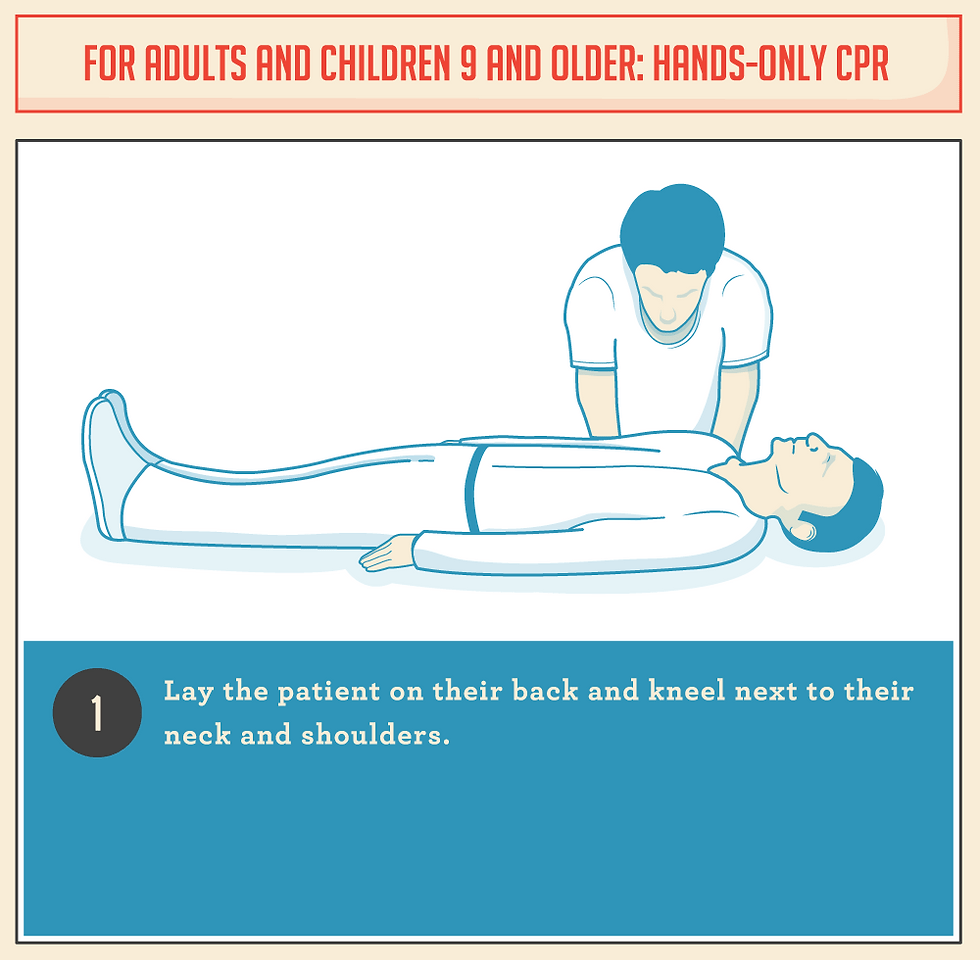Anybody can and anybody should learn how to perform CPR (Cardiopulmonary resuscitation): According to the American Heart Association, a stunning 70% of Americans don’t know how what to do if somebody is experiencing a cardiac emergency because they don’t know how to administer CPR or they forgot the exact technique. This is especially alarming since almost 90% of cardiac arrests occur at home — where patients depend on the immediate respiratory care response of their family members. In brief, knowing how to perform CPR can save the life of a loved one someday.




While 400,000 cardiac arrests happen outside of hospitals each year in the U.S. alone, hands-on CPR can actually double or triple an adult’s chance of survival. However, you need to act quickly. At four minutes without oxygen, the patient will suffer from permanent brain damage. At eight to ten minutes, the patient can die. Almost 90% of cardiac arrest patients die because no one performed CPR at the scene.
Before You Start CPR
First of all, check if the patient can respond by tapping them on the shoulder and shouting “Are you okay?” If they don’t respond, call for medical emergency services immediately. If others are around, instruct them to call 911 and if you’re alone, do it yourself. If the patient is an animal, call the closest animal hospital. If you happen to be near an AED (defibrillator), read the instructions and give one shock to the patient (this applies to humans only).
CPR Steps For Adults and Children 9 and Older: Hands-Only CPR
Lay the patient on their back and kneel next to their neck and shoulders.
Place the heel of one hand on the center of the patient’s chest.
Place the heel of your other hand over the first and lace fingers together.
Keep your elbows straight and align your shoulders directly over your hands.
Begin compression:
As hard as possible
At least 100x/minute
Allow the chest to rise fully between compressions.
TIP: Give compressions to the beat of disco hit “Stayin’ Alive”!
CPR Steps For Younger Children and Infants
Tilt the head back a bit and lift chin to open the airway and check for breathing.
If there’s no breathing, give either of these two rescue breaths:
Child: Pinch the nose shut and make a complete seal over their mouth
Infant: Make a complete seal over their mouth and nose.
Blow in for one second, so the chest visibly rises and repeat this once.
Give 30 chest compressions (100x/minute):
Child: Push with one or two hands about two inches deep
Infant: Push with two to three fingers about 1.5 inches deep.
Repeat these steps three to four times.
Pet CPR – For Dogs and Cats
For Animals Under 10kg/22lbs:
Use the one-handed technique, wrapping the hand over sternum and chest.
Give 30 chest compressions (100-120x/minute).
Allow the chest to fully recoil between compressions.
Give two mouth-to-snout rescue breaths after each set of compressions (30:2).
For Medium to Giant Dogs:
Position the animal on its side.
Use the two-handed technique, placing your hands over the widest part of the chest.
For Deep, Narrow-Chested Dogs Like Greyhounds:
Use the two-handed technique, placing your hands directly over the heart.
For Barrel-Chested Dogs Like English Bulldogs:
Place animal on its back and use the same positioning and technique as for adult humans Whether you perform CPR on an adult, child, infant, or pets, DO NOT STOPunless:
The patient starts breathing
An EMS or another citizen responder takes over
An AED is ready to use
The scene becomes unsafe
You are physically incapable of continuing
Make sure to practice and/or brush up your CPR abilities today, so you’re ready to potentially save someone’s life in the future! Furthermore, if you’re interested in making it your profession to help people suffering from respiratory conditions like asthma, bronchitis, lung cancer, heart attack, stroke, chronic obstructive pulmonary disease (COPD) or sleep apnea, you should look into Carrington College’s respiratory care program. This two-year program combines classroom lectures, laboratory instruction, and clinical experience in order to prepare you to work in a variety of healthcare settings. If you’d like to assist and educate people regarding respiratory health concerns, our training program is the ideal fit for you!
Learn, Enjoy and Save Life. Healthforce Training Center offer services such as Basic Life Support (BLS), Advance Cadiovascular Life Support (ACLS), Pediatric Advance Life Support (PALS), CPR AED, Pediatric First Aid CPR AEDand First Aid CPR AED. Read more of our blogs.


AV在线看 AV在线看;
自拍流出 自拍流出;
国产视频 国产视频;
日本无码 日本无码;
动漫肉番 动漫肉番;
吃瓜专区 吃瓜专区;
SM调教 SM调教;
ASMR ASMR;
国产探花 国产探花;
强奸乱伦 强奸乱伦;
代发外链 提权重点击找我;
蜘蛛池 蜘蛛池;
谷歌马甲包/ 谷歌马甲包;
谷歌霸屏 谷歌霸屏;
谷歌霸屏 谷歌霸屏
蜘蛛池 蜘蛛池
谷歌快排 谷歌快排
Google外链 Google外链
谷歌留痕 谷歌留痕
Gái Gọi…
Gái Gọi…
Dịch Vụ…
谷歌霸屏 谷歌霸屏
负面删除 负面删除
币圈推广 币圈推广
Google权重提升 Google权重提升
Google外链 Google外链
google留痕 google留痕
代发外链 提权重点击找我;
游戏推广 游戏推广;
Fortune Tiger Fortune Tiger;
Fortune Tiger Slots Fortune…
谷歌马甲包/ 谷歌马甲包;
谷歌霸屏 谷歌霸屏;
מכונות ETPU מכונות ETPU;
;ماكينات اي تي بي…
آلات إي بي بي…
ETPU maşınları ETPU maşınları;
ETPUマシン ETPUマシン;
ETPU 기계 ETPU 기계;
google seo google seo技术飞机TG-cheng716051;
03topgame 03topgame
gamesimes gamesimes;
Fortune Tiger Fortune Tiger;
Fortune Tiger Slots Fortune Tiger…
Fortune Tiger Fortune Tiger;
EPS машины EPS машины;
Fortune Tiger Fortune Tiger;
EPS Machine EPS Cutting Machine;
EPS Machine EPS and EPP…
EPP Machine EPP Shape Moulding…
EPS Machine EPS and EPP…
EPTU Machine ETPU Moulding Machine
EPS Machine EPS Cutting Machine;
google seo google seo技术飞机TG-cheng716051;
03topgame 03topgame
gamesimes gamesimes;
Fortune Tiger Fortune Tiger;
Fortune Tiger Slots Fortune Tiger…
Fortune Tiger Fortune Tiger;
EPS машины EPS машины;
Fortune Tiger Fortune Tiger;
EPS Machine EPS Cutting Machine;
EPS Machine EPS and EPP…
EPP Machine EPP Shape Moulding…
EPS Machine EPS and EPP…
EPTU Machine ETPU Moulding Machine
EPS Machine EPS Cutting Machine;